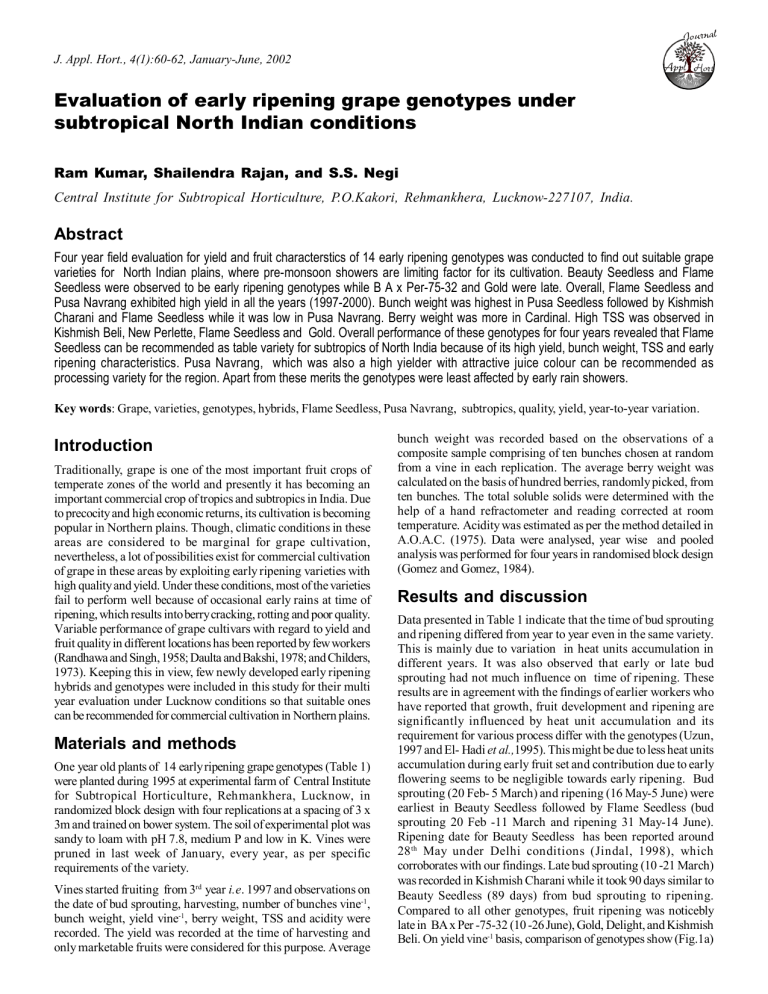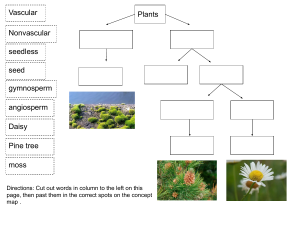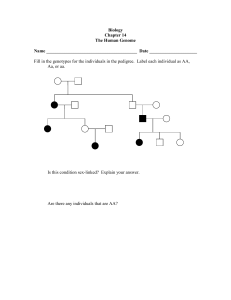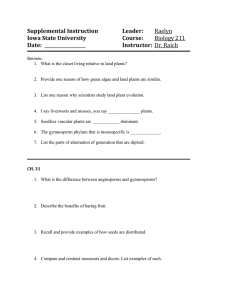
J. Appl. Hort., 4(1):60-62, January-June, 2002 Evaluation of early ripening grape genotypes under subtropical North Indian conditions Ram Kumar, Shailendra Rajan, and S.S. Negi Central Institute for Subtropical Horticulture, P.O.Kakori, Rehmankhera, Lucknow-227107, India. Abstract Four year field evaluation for yield and fruit characterstics of 14 early ripening genotypes was conducted to find out suitable grape varieties for North Indian plains, where pre-monsoon showers are limiting factor for its cultivation. Beauty Seedless and Flame Seedless were observed to be early ripening genotypes while B A x Per-75-32 and Gold were late. Overall, Flame Seedless and Pusa Navrang exhibited high yield in all the years (1997-2000). Bunch weight was highest in Pusa Seedless followed by Kishmish Charani and Flame Seedless while it was low in Pusa Navrang. Berry weight was more in Cardinal. High TSS was observed in Kishmish Beli, New Perlette, Flame Seedless and Gold. Overall performance of these genotypes for four years revealed that Flame Seedless can be recommended as table variety for subtropics of North India because of its high yield, bunch weight, TSS and early ripening characteristics. Pusa Navrang, which was also a high yielder with attractive juice colour can be recommended as processing variety for the region. Apart from these merits the genotypes were least affected by early rain showers. Key words: Grape, varieties, genotypes, hybrids, Flame Seedless, Pusa Navrang, subtropics, quality, yield, year-to-year variation. Introduction Traditionally, grape is one of the most important fruit crops of temperate zones of the world and presently it has becoming an important commercial crop of tropics and subtropics in India. Due to precocity and high economic returns, its cultivation is becoming popular in Northern plains. Though, climatic conditions in these areas are considered to be marginal for grape cultivation, nevertheless, a lot of possibilities exist for commercial cultivation of grape in these areas by exploiting early ripening varieties with high quality and yield. Under these conditions, most of the varieties fail to perform well because of occasional early rains at time of ripening, which results into berry cracking, rotting and poor quality. Variable performance of grape cultivars with regard to yield and fruit quality in different locations has been reported by few workers (Randhawa and Singh, 1958; Daulta and Bakshi, 1978; and Childers, 1973). Keeping this in view, few newly developed early ripening hybrids and genotypes were included in this study for their multi year evaluation under Lucknow conditions so that suitable ones can be recommended for commercial cultivation in Northern plains. Materials and methods One year old plants of 14 early ripening grape genotypes (Table 1) were planted during 1995 at experimental farm of Central Institute for Subtropical Horticulture, Rehmankhera, Lucknow, in randomized block design with four replications at a spacing of 3 x 3m and trained on bower system. The soil of experimental plot was sandy to loam with pH 7.8, medium P and low in K. Vines were pruned in last week of January, every year, as per specific requirements of the variety. Vines started fruiting from 3rd year i.e. 1997 and observations on the date of bud sprouting, harvesting, number of bunches vine-1, bunch weight, yield vine-1, berry weight, TSS and acidity were recorded. The yield was recorded at the time of harvesting and only marketable fruits were considered for this purpose. Average bunch weight was recorded based on the observations of a composite sample comprising of ten bunches chosen at random from a vine in each replication. The average berry weight was calculated on the basis of hundred berries, randomly picked, from ten bunches. The total soluble solids were determined with the help of a hand refractometer and reading corrected at room temperature. Acidity was estimated as per the method detailed in A.O.A.C. (1975). Data were analysed, year wise and pooled analysis was performed for four years in randomised block design (Gomez and Gomez, 1984). Results and discussion Data presented in Table 1 indicate that the time of bud sprouting and ripening differed from year to year even in the same variety. This is mainly due to variation in heat units accumulation in different years. It was also observed that early or late bud sprouting had not much influence on time of ripening. These results are in agreement with the findings of earlier workers who have reported that growth, fruit development and ripening are significantly influenced by heat unit accumulation and its requirement for various process differ with the genotypes (Uzun, 1997 and El- Hadi et al.,1995). This might be due to less heat units accumulation during early fruit set and contribution due to early flowering seems to be negligible towards early ripening. Bud sprouting (20 Feb- 5 March) and ripening (16 May-5 June) were earliest in Beauty Seedless followed by Flame Seedless (bud sprouting 20 Feb -11 March and ripening 31 May-14 June). Ripening date for Beauty Seedless has been reported around 28 th May under Delhi conditions (Jindal, 1998), which corroborates with our findings. Late bud sprouting (10 -21 March) was recorded in Kishmish Charani while it took 90 days similar to Beauty Seedless (89 days) from bud sprouting to ripening. Compared to all other genotypes, fruit ripening was noticebly late in BA x Per -75-32 (10 -26 June), Gold, Delight, and Kishmish Beli. On yield vine-1 basis, comparison of genotypes show (Fig.1a) Kumar et al.-Evaluation of early ripening grape genotypes Table 1. Variation in date of bud sprouting and ripening in early ripening grape genotypes Genotypes Date of bud sprouting 1997 1998 1999 2000 1997 Kishmish Charani (KC)17-Mar 10-Mar 10-Mar 21-Mar 16-Jun Delight (DE) 10-Mar 26-Feb 26-Feb 10-Mar 19-Jun Pusa Navrang(PN) 8-Mar 26-Feb 1-Mar 10-Mar 16-Jun Cardinal (CA) 16-Mar 7-Mar 2-Mar 18-Mar 17-Jun Kishmish Beli(KI) 10-Mar 7-Mar 2-Mar 16-Mar 17-Jun Perlette (PE) 13-Mar 2-Mar 3-Mar 16-Mar 19-Jun Pusa Seedless(PS) 14-Mar 26-Feb 3-Mar 16-Mar 17-Jun Gold (GO) 14-Mar 2-Mar 29-Feb 16-Mar 26-Jun Beauty Seedless(BS) 2-Mar 20-Feb 26-Feb 5-Mar 28-May Flame Seedless(FS) 11-Mar 20-Feb 27-Feb 10-Mar 4-Jun New Perlette(NP) 8-Mar 20-Feb 24-Feb 7-Mar 15-Jun Pusa Urvashi (PU) 11-Mar 26-Feb 27-Feb 16-Mar 16-Jun BA x Per- 75-32 (BP) 10-Mar 24-Feb 27-Feb 11-Mar 26-Jun BA x BS-71-50 (BB) - Harvesting date 1998 1999 8-Jun 10-Jun 10-Jun 11-Jun 5-Jun 11-Jun 8-Jun 31-May 10-Jun 10-Jun 8-Jun 9-Jun 9-Jun 8-Jun 8-Jun 12-Jun 30-May 16-May 31-May 4-Jun 7-Jun 9-Jun 6-Jun 17-Jun 10-Jun 15-Jun - 61 2000 16-Jun 18-Jun 12-Jun 12-Jun 18-Jun 13-Jun 15-Jun 16-Jun 5-Jun 14-Jun 8-Jun 14-Jun 14-Jun - 25 LSD (p=0.05) 99 20 2000 98 15 97 10 KC DE PN CA 2000 KI PE PS GO BS FS NP PU 500 2000 400 97 99 98 BP 15 10 5 b 99 b 60 40 20 60 300 c 50 98 200 80 0 70 LSD (p=0.05) CV(%) Number of bunches/vine a 0 100 0 97 40 30 20 100 10 0 0 KC DE PN 400 Bunch weight (g) 20 5 Total yield (kg) Fruit yield (kg/vine) 25 Mean yield (kg) a 30 300 a CA 2000 KI PE PS GO BS FS NP PU BP LSD (p=0.05) 99 2000 97 98 97 98 99 c 200 100 KC DE PN CA 97 98 99 2000 0 KI PE PS GO BS FS NP PU BP Fig. 1. Fruit yield/ vine (a), number of bunches/vine (b) and bunch weight (c) in early ripening grape genotypes KC DE PN CA KI PE PS GO BS FS NP PU BP Genotype Fig. 2. Mean yield(a), total yield(b) and coefficient of variation(c) in yield pattern of early ripening grape genotypes that Flame Seedless and Pusa Navrang were high yielding genotypes and mean yield of these genotypes over 4 years was about 20 kg vine-1 year-1 . The total yield of 4 years was also high in Flame Seedless and Pusa Navrang (Fig.2). This show that yearly yield fluctuation was less in these genotypes as expressed by coefficient of variation (Fig 2c). Genotypes, Delight, Gold, New Perlette had more flactuation in yield vine-1.The yield data of genotypes, recorded in different years also indicate that total yield of Flame Seedless and Pusa Navarang were not only high but they also recorded phenotypic yield stability and show potential for satisfactory yield and fruit quality under unfavourable conditions. Observations for four years have also shown that damage due to early rains is not apparent on Flame Seedless and Pusa Navrang, while BA x Per-75-32 and New Perlette were highly susceptible to cracking under the influence of light showers also. Genotypes, Cardinal (5.40 - 8.61kg vine-1), Kishmish Charani (4.69 -12.66 kg 62 Kumar et al.-Evaluation of early ripening grape genotypes Table 2. Variation in berry weight, acidity and TSS of early ripening grape genotypes Genotype Berry weight (g) Acidity (%) TSS (oBrix) 1997 1998 1999 2000 Mean 1997 1998 1999 2000 Mean 1997 1998 1999 2000 Mean Kishmish Charani 1.41 1.72 1.65 1.60 1.60 0.80 0.80 0.75 0.88 0.81 16.6 15.8 15.4 17.8 16.4 Delight 1.30 0.92 1.43 1.80 1.36 0.50 0.45 0.45 0.57 0.49 17.00 16.80 17.00 18.20 17.25 Pusa Navrang 0.97 1.68 0.64 1.80 1.27 0.65 0.60 0.42 0.56 0.56 16.00 16.40 15.20 16.60 16.05 Cardinal 2.34 3.99 2.11 3.60 3.01 0.60 0.50 0.39 0.48 0.49 15.60 15.20 17.80 18.00 16.65 Kishmish Beli 1.41 1.31 1.36 1.20 1.32 0.45 0.45 0.43 0.45 0.45 21.40 18.00 17.67 18.00 18.77 Perlette 1.53 1.57 1.54 1.43 1.52 0.60 0.63 0.58 0.57 0.60 16.80 17.07 16.67 18.80 17.34 Pusa Seedless 1.95 2.02 1.98 1.50 1.86 0.75 0.58 0.60 0.57 0.63 18.00 17.13 17.13 18.40 17.67 Gold 2.10 1.86 1.92 1.93 1.95 0.50 0.45 0.44 0.56 0.49 21.00 15.40 17.67 18.40 18.12 Beauty Seedless 1.50 2.89 2.14 1.60 2.03 0.60 0.50 0.50 0.66 0.57 16.00 18.20 16.80 18.20 17.30 Flame Seedless 1.49 1.33 1.08 1.50 1.35 0.50 0.50 0.47 0.49 0.49 20.40 17.20 17.00 18.80 18.35 New Perlette 1.56 1.75 0.89 1.30 1.38 0.65 0.65 0.60 0.56 0.62 20.40 17.20 16.60 19.20 18.35 Pusa Urvashi 1.66 1.65 1.54 1.60 1.61 0.60 0.60 0.47 0.57 0.56 15.80 16.27 16.33 15.87 16.07 BA x PER-75-32 1.84 1.88 1.34 1.68 1.69 1.10 0.72 0.38 0.75 0.74 9.00 10.80 9.20 9.53 9.63 BA x BS-71-50 CD (p=0.05) 0.12 0.14 0.13 0.13 0.13 0.17 0.18 0.10 0.17 0.08 0.71 0.57 0.38 0.70 0.30 vine-1), Beauty Seedless (1.13-22.63 kg), Pusa Seedless (5.02 - 7.13 kg vine-1), Gold (1.36 kg - 8.88 kg vine-1) and New Perlette (2.69 kg - 9.84 kg vine-1) recorded medium yield, while Pusa Urvashi (1.20 2.89kg vine-1) and Kishmish Beli (1.15 - 3.04 kg vine-1) were observed as poor yielder under Lucknow conditions. These results are in agreement with the findings of Cheema et al. (1998) from Ludhiana and Jindal (1998) in Delhi conditions. The results of present investigation are contradictory with the results of Gaurav et al. (2000) who received maximum yield with Beauty Seedless under Rahauri conditions whereas under Lucknow conditions it was observed as medium yielder. This variation may be due to difference in agro-climatic conditions. Under Lucknow conditions, hybrid BA x BS-71-50 did not produce fruits throughout the experimental period . Poor yield behaviour of this hybrid has also been reported from Delhi (Singh, 1996). Number of bunches vine-1 was maximum in Pusa Navrang although its bunch weight was minimum (Fig.1b). The low bunch weight might be due to high number of bunches causing competition among the berries and resulting into smaller size. The results also indicate that in Flame Seedless, number of bunches was significantly higher than other genotypes except Pusa Navrang along with high bunch weight. Although Kishmish Charani, Pusa Seedless and New Perlette had high bunch weight but exhibited less yield under Lucknow conditions (Fig. 1a,1c). Because of higher yield, Pusa Navrang can be exploited as processing variety for juice making as of it has attractive juice colour. Thus smaller berry size and seededness are not the limiting factor for the cultivationo of this genotypes. Flame Seedless was adjudged as suitable genotype for subtropics not only due to high yield and stability in various environments but also its highly attractive flame colour and satisfactory berry and bunch size with sufficient number of bunches vine-1. Highest bunch weight was observed in Pusa Seedless (279.75g) followed by Kishmish Charani (231.17g), Flame Seedless (226.25g) and New Perlette (215.50g). Higher (3.01g) berry weight was recorded in Cardinal as compared to others and it was minimum (1.27g) in Pusa Navrang. Tomar (1990) also recorded the high berry weight in Cardinal under arid irrigated conditions of Punjab. The next higher berry weight was recorded in Beauty Seedless (2.03g), Gold (1.95g) and Pusa Seedless (1.86g). TSS was maximum in Kishmish Beli (18.770 Brix), New Perlette (18.350 Brix ), Flame Seedless (18.350 Brix) and Gold (18.40 Brix) were at par in this parameter while it was minimum in hybrid BA x Per 75-32. Minimum acidity ( 0.44%) was observed in Kishmish Beli followed by Delight, Cardinal, Gold and Flame Seedless whereas, it was maximum (0.75-0.88%) in Kishmish Charani and BA x Per -75-32 (0.74%), respectively. Gaurav et al. (2000) also reported highest TSS and lower acidity in Flame Seedless. Sable and Tambe (1996) have also reported more acidity in the juice of Kishmish Charni. Results of this investigation indicated that Flame Seedless is most suitable table variety for the commercial cultivation under Lucknow conditions and Pusa Navrang was next suitable variety for the region particulary for juice making. References A.O.A.C, 1975. Official Methods of Analysis. Association of official analytical Chemists. 12th Edition, Washington D.C. Cheema S.S., J.S. Kamboj and B.S. Chahal, 1998. Collection and evaluation of germplasm. Res. Rept. All India Coordinated Project on Subtropical Fruits held at Kalyani, India, p 42. Childers, N.F. 1973. Modern Fruit Science. Fifth Edn. Horticultural Publications, Rutgers University, New Jersey, 08903-USA. El- Hadi, M. El- Ghawawi and K. Al- Habash, 1995. Heat requirements of annual cycle growth of certain cultivars of grape (Vitis vinifera L.). Acta Hortic., 388:59-63. Daulta, B.S. and J.C. Bakshi. 1978. Evaluation of Vinifera varietiesII. Yield and fruiting behaviour. Haryana J. Hort. Sci., 7:156-61. Gaurav, S.B., V.K. Garnade and T.B. Tambe, 2000. Collection and evaluation of germplasm. Res. Rept. All India Coordinated Project on Subtropical Fruits held at Navsari, India, p 20. Gomez, K.A. and A.A. Gomez, 1984. Statistical procedures for Agricultural Research. John Wiley and Sons. Inc. New York, pp.411-420. Jindal, P.C. 1998. Collection and evaluation of germplasm. Res. Rept. All India Coordinated Project on Subtropical Fruits held at Kalyani, India, p 40. Randhawa, G.S. and J.P. Singh. 1958. Varietal diversity and improvement of grapes, Indian J. Hort., 15:220-29. Sable, M.B. and T.B. Tambe, 1996. Collection and evaluation of germplasm. Res. Rept. All India Coordinated Project on Subtropical Fruits held at Pantnagar, 30. Singh, K. 1996. Hybridization and evaluation of hybrids. Res. Rept. All India Coordinated Project on Subtropical Fruits held at Pantnagar, India, p 39. Tomar, N.S. 1990. Evaluation of grape cultivars under arid-irrigated conditions of Punjab. Haryana J. Hort. Sci., 20(1-2):1-5. Uzun, H.I. 1997. Heat Summation requirements of grape cultivars. Acta Hortic., 441:383-386. 120 Kumar et al.-Evaluation of early ripening grape genotypes




